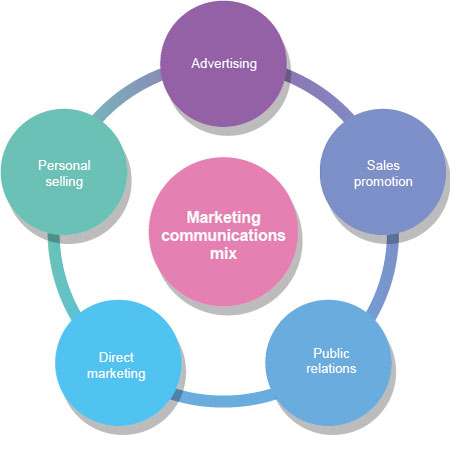6 Marketing communications mix in the digital era
This section introduces the key components in the marketing communication mix, digital marketing communications tools, different types of media, and how to select the correct media for your audience.
The marketing communication mix
At the core of marketing communications is a collection of tools and methods through which organisations communicate with their audiences. This is referred to as the marketing communications mix (MC mix).
The five main components of the MC mix are shown in Figure 8.
Now you will be briefly introduced to each of these tools and their role in the MC mix.
Advertising
Advertising is far more than just a form of impersonal, paid-for communication. It draws from popular culture, but it also plays a significant role in shaping the cultural landscape. And, with the development of digital technology, its cultural influence is only expanding.
Advertising is highly effective as an initial tool used to create awareness about an organisation’s offering. It also plays a part in creating consumer interest and desire. Importantly, it is also a primary tool for helping reinforce a purchase after the event and can be used to positively affirm to consumers that they have made the right decision. Although traditional modes of advertising have a weak influence at the point of purchase, online and digital advertising is changing this. Display pop-ups that encourage an immediate purchase, often through a time-based window, are blurring the lines between advertising, direct mail and sales promotion, and in-app purchases use similar strategies.
Sales promotion
Sales promotions are short-term incentives that aim to stimulate sales and increase customer demand. Sales promotion is often used as a tool of immediacy in order to encourage customers to act in the moment, to make larger purchases, and/or to make repeat purchases. The main advantage of sales promotion is the short-term sales boost that can be achieved when customers take advantage of an offer.
Sales promotions are also an important aspect of non-commercial marketing communications campaigns. For example, public health campaigns on safe sex might include the distribution of free contraceptives, or anti-smoking campaigns might offer free nicotine replacement products.
One of the most common strategies in marketing communications is to combine sales promotion with advertising to stimulate interest and desire.
Public relations (PR)
PR involves communications released by the organisation that are designed to help improve and promote its image. It is about building good relations with the organisation’s target audiences (not just customers) through obtaining favourable publicity, building and maintaining a positive corporate image, and handling or heading off unfavourable rumours, stories, and events.
PR activities are primarily used for creating awareness. PR is also an effective tool post-purchase, where it covers areas such as after-sales services and handling customer complaints.
In the internet age, PR has become a much more important element of the MC mix. The need to manage and control the flow of information about an organisation has become more critical in the light of social media and other sites that provide a platform for those that might seek to challenge, question or undermine the reputation of the organisation.
Sponsorship
There are two main types of sponsorship:
- philanthropy: the patronage or donation of funds or resources to a cause or organisation e.g. a charity, arts foundation, heritage site
- commercial sponsorship: paid-for sponsorship by organisations normally with the acknowledgement of that arrangement through the display of the sponsor’s brand or logo.
Sponsorship can be seen to have several strategic uses in a marketing communications campaigns, including raising awareness, building positive brand image and perceptions, and creating positive media attention.
Direct marketing
Direct marketing (incorporating interactive and database marketing) is an approach that seeks to target individual customers with personalised messages and to build lasting relationships. Direct marketing can be directed at a named person who may have a personal interest in the products or services being offered. However, the effectiveness of direct mail is debatable as much of it ends up unopened or misdirected. Moreover, a lot of time and resources are required to manage and update direct mail databases.
Direct marketing is a primary tool used to build awareness and interest in an offering. It is a method that can target individual customers and convey significant amounts of information compared to advertising. As such, direct marketing is often a supplementary tool for communicating an organisation’s offerings.
Personal selling
Personal selling involves interpersonal communication between the organisation and external parties. As such, personal selling is a two-way communications tool that provides the opportunity for customers to pose questions, make a comment, express an objection, or indicate their reactions through their body language and nonverbal responses such as gestures. Moreover, the salesperson has the advantage of receiving instant feedback through interaction with customers, which is not the case when using mass media.
Personal selling is the most effective tool during the purchase stage. This is understandable as the interaction with the customer, and the ability to modify and personalise the brand message, is much more achievable.

